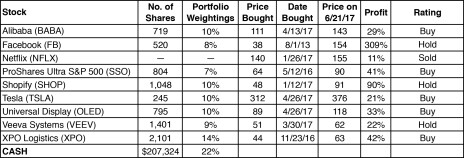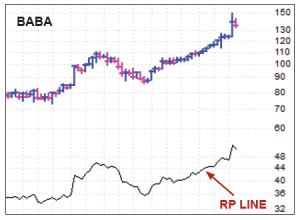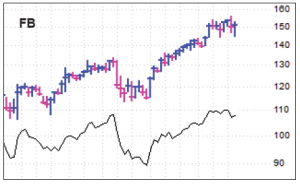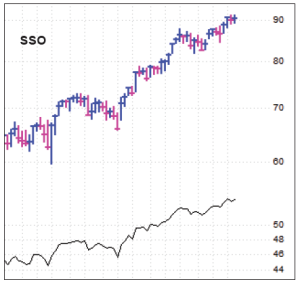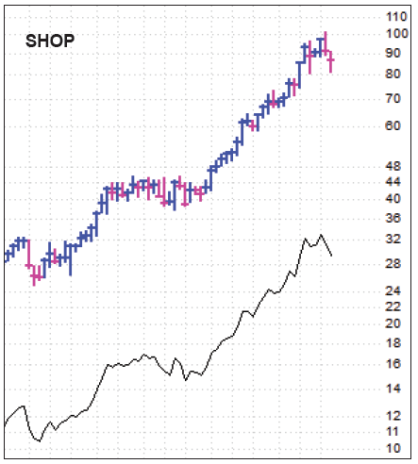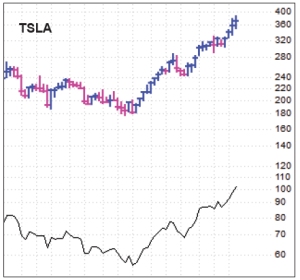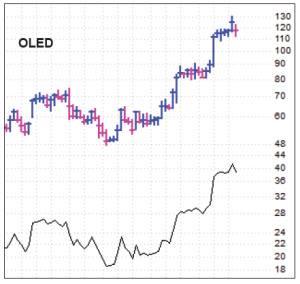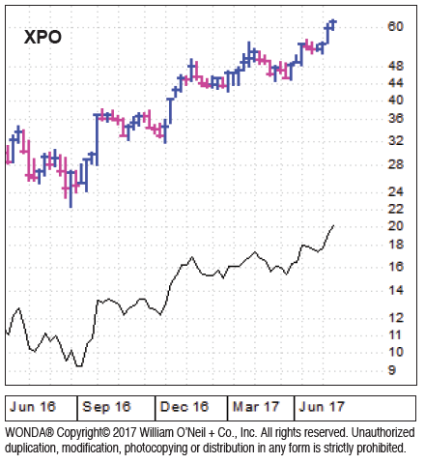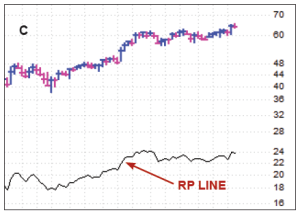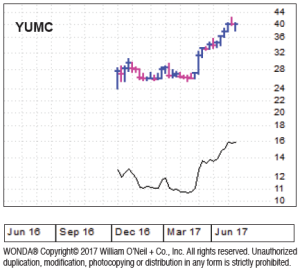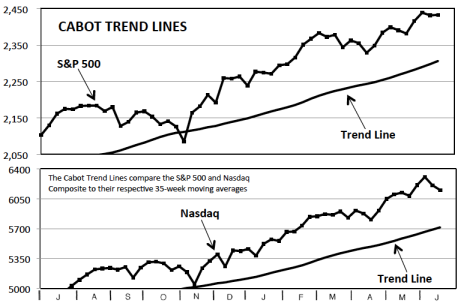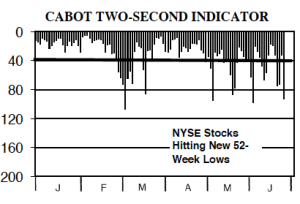In tonight’s issue, we give you our latest thoughts on each of our stocks and take a deep dive into the issue of handling big winners—a skill that few practice, but done right, it will make a huge difference in your portfolio.
Cabot Growth Investor 1370
[premium_html_toc post_id="135419"]
Smoke, But No Fire (Yet)
The eight weeks from mid-April to the beginning of June were fantastic for growth investors—the type of environment that makes grinding through all those choppy, news-driven periods worth it. The Model Portfolio was up 16% in those eight weeks alone!
But during the past two weeks, we’ve seen sellers put up a fight, especially when it comes to leading stocks and the Nasdaq. The wave of distribution on June 9 and June 12 resulted in some abnormal selling in a variety of names and cracked a few of them. Netflix (NFLX) was one that broke down, and we quickly took our small profit in the portfolio and held the cash.
And this says nothing about the broad market, which continues to be weighed down by the energy sector (our Two-Second Indicator remains unhealthy) or the divergences of the past few months (small- and mid-caps continue to lag). Looking at the evidence altogether, there’s a good amount of smoke.
But is there an actual fire? Not yet. Both of our trend-following market-timing indicators remain positive, and importantly, the number of institutional-quality leading growth stocks that have broken down is small. (Interestingly, on a very short-term basis, the Nasdaq found support five times in recent days in the 6,100 to 6,150 area.) That’s why we remain mostly invested and haven’t taken much action apart from selling Netflix.
From here, it’s best to play it by the book. We’re open to the possibility that after a long run (the market hasn’t had a meaningful pullback since last November’s election, seven months ago!), stocks could encounter a summer storm. If so, we’ll ditch any stocks that crack and build on our current 22% cash position.
But as we often preach, trends often go farther and last longer than just about anyone expects, so we’re certainly not going to put any limits on this advance. The longer that leading stocks and the Nasdaq can hold up, in fact, the greater the chance that the recent wave of selling was another short-term shakeout that will give way to another leg up.
If the uptrend does resume, we’ll look to put our cash to work, ideally in some “early stage” situations, i.e., stocks that got going just a couple of months ago and thus have greater potential upside as buyers continue to build positions. We see many such opportunities; our favorites are on our Watch list.
[highlight_box]WHAT TO DO NOW: Remain mostly bullish, but keep your eyes open—the next week or two will probably go a long way toward telling us whether a deeper correction is unfolding or whether it’s time to put our cash to work. Tonight, we’re sitting tight with eight stocks and a cash position of 22%.[/highlight_box]
Model Portfolio Update
So far, so good when it comes to the Model Portfolio’s action following the large wave of distribution nearly two weeks ago. Just about all of our stocks took good-sized hits, and one of them (Netflix) showed some abnormal weakness, which caused us to sell. But our other stocks have held key support and bounced well since.
The sale of Netflix left us with 22% in cash, which we think is fine for now. We’ll raise more cash if growth stocks suffer additional bouts of distribution, but we’re also fine-tuning our short watch list—another day or two of constructive action (in growth stocks and most major indexes) could have us putting some money back to work.
Current Recommendations
BUY—Alibaba (BABA 143)—In every sustained bull move, there are usually a choice handful of big, liquid leading stocks that have a rare combination of trading volume, current growth and long-term potential. Should the bull market continue (as we expect), we think BABA is positioned as the #1 liquid leader of this advance, especially since the company dramatically hiked this year’s revenue outlook (up 47%) at its recent Investor Day, stating that it expects gross merchandise volume through its platforms to nearly double by 2020, and setting a (very) long-term goal of two billion customers (up from 560 million today) in 15 years. The stock held up well during the growth stock selloff, falling just eight points (on a closing basis) before snapping back. With the 50-day line still down around 123, some further ups and downs could easily come, but we think BABA is rare merchandise that institutional investors will look to accumulate over time. If you own some, hang on, and if you don’t, you could buy a small (half-sized) position here or on dips of a few points.
HOLD—Facebook (FB 154)—Another week, another interesting data point for the nascent virtual and augmented reality industry—IDC expects industry-wide shipments of VR and AR headsets to grow to 100 million annually by 2021, up from 10 million last year and just 2.3 million in the first quarter of this year. Virtual reality isn’t likely to be a near-term driver of the firm’s business, but it’s clear Facebook’s Oculus subsidiary has a huge opportunity in the years ahead, adding to the company’s long-term growth potential. Meanwhile, in terms of current revenue drivers, Instagram Stories (kind of a ripoff of Snapchat’s idea) has proven wildly popular, with 250 million daily active users now, up from 200 million in April and much larger of Snapchat’s user base. As for the stock, it’s been all over the place on a day-to-day basis, but net-net, has stayed between 145 and 155 for the past seven weeks. Should the stock settle down and offer up a low-risk entry point, we could go back to Buy, but right here we’re just sitting tight and giving shares room to breathe.
SOLD—Netflix (NFLX 155)—NFLX looked like it was ready for great things after its breakout in late April (following a shakeout on earnings), and shares did push higher for the next few weeks. But the stock was never as powerful as most other leaders, and the recent market selloff pushed the stock below its 50-day line and it hasn’t been able to bounce much since. Going by the evidence in front of us, we decided to book our small profit last week and hold the cash.
BUY—ProShares Ultra S&P 500 Fund (SSO 90)—The S&P 500 took the growth stock selling in stride last week and, this week, lifted to new highs on Monday before easing some the past two days. We continue to think owning a position in a leveraged long fund of a major market index is a good, lower-risk way to ride a bull market, and SSO has proven that during the 15 months that we’ve owned it. Hang on if you own some, and if you don’t, you can buy here or on dips of a point or two.
HOLD—Shopify (SHOP 91)—We flipped SHOP back to a Hold rating last week due to its heavy-volume selling after hitting resistance twice in the 95 to 100 area in May and June. Thus, chart-wise, while nothing is certain, the odds are growing that the stock may need a rest. That said, the recent action is far from the end of the world—in fact, we’re aiming to play SHOP out for a longer-term advance due to its humongous story, improving competitive position and, technically, the fact that the stock has advanced only five months since its breakout. (We write a lot more about handling winners, including SHOP, on page 6.) Right now, though, we’re sticking with a Hold rating. There’s a chance we could trim a few more shares if the stock (or market) gets ugly, but our goal is to hold at least half our original position (we’ve already sold one-third) through a correction, thinking that higher prices are likely in the months ahead.
BUY—Tesla (TSLA 376)—Tesla has been showing classic “tennis ball” action, falling for just one day during the recent growth stock selloff, immediately snapping back to new highs and holding most of its the gains since. The stock has been helped by a series of positive news (reports indicate Tesla could soon open a production plant in China; CEO Elon Musk said they were in discussions to get out of import penalties from India; Model X is the first SUV to earn a five-star crash rating in every category) and commentary (one analyst sees Tesla’s cash flow per vehicle as 50% larger than competitors once it scales up). Of course, the real key will be actual data points in the weeks ahead concerning second-quarter deliveries and production figures (likely reported in early July), updates on the Model 3 production ramp and, of course, whether the firm is doing everything cost-effectively. The fundamental potential, the fact that the stock is relatively early in its new advance (just breaking out in April) and TSLA’s recent strength are all encouraging. We’ll stay on Buy.
BUY—Universal Display (OLED 118)—OLED definitely moves around a lot, but we think its recent dip is completely normal. During the first two days of the growth stock selloff (June 9 and 12), the stock fell from a high of 131 to a low of 112—nearly 15%—but it hasn’t closed much below its 25-day line. Fundamentally, all signs continue to point toward a boom in organic light emitting diode demand. In its first-quarter conference call, Universal Display outlined huge investment plans by Samsung, LG, Sharp and AU Electronics this year in smartphones, TVs and wearables. All told, demand is expected to triple by 2020, so if Universal Display executes on its plan, earnings should surge for a long time. We think the current dip is buyable.
HOLD—Veeva Systems (VEEV 62)—In the last issue, we noted that VEEV had shown a bit of climax-type action before and after earnings in May, and the big-volume drop two weeks ago was enough for us to place the stock on Hold. The stock has bounced off its 50-day line since, but going forward, we’re going to let the stock tell us what to do—if VEEV can hold above the 55 to 56 area, we’re more than happy to hang on and give shares room to catch their breath. However, a breakdown would likely imply that the stock needs a deeper consolidation and would have us selling. (Plus, we don’t want to give back too much of our prior profit, which is a point of emphasis for us after studying our trades of the past couple of years.) Right now, we’re sticking to our Hold rating, but will watch the stock’s action carefully.
BUY—XPO Logistics (XPO 63)—We field many questions that involve something related to “Is XYZ stock extended to the upside?”—and the answer usually has a lot to do with where a stock is in its overall advance. If a stock breaks out in a big way and becomes very extended over the next couple of weeks, that’s usually a good thing, telling you there’s power behind the move. Such is the case with XPO Logistics. There are no sure things, but the six-month up-and-down action, recent breakout and excellent upside follow-through are likely a sign that a sustained uptrend has begun. Fundamentally, we were intrigued to hear that, with the firm well on its way toward wringing efficiencies out of some big 2014-2015 acquisitions, CEO Bradley Jacobs is again starting to hunt for new targets, though it will stick to buyouts that boost its current business lines. All told, we’re sticking to our Buy rating, thinking any dips will present good opportunities to enter.
Watch List
Autodesk (ADSK 106): ADSK remains in good shape as it consolidates its recent run. We think the firm’s shift to a cloud- and recurring revenue-based model will result in booming cash flow, which big investors are sniffing out now. (Fidelity owns more than 13% of the company!)
PayPal (PYPL 54): PYPL’s pullback has been modest during the past two weeks; if all’s well, the 50-day line (in the 49 to 50 area) should provide support on further weakness. We think the stock is early in a new uptrend.
ServiceNow (NOW 106): NOW’s dip has been a bit uglier than we’d prefer, but it’s still worth keeping on our Watch List—there aren’t many companies expanding sales, earnings and cash flow at 30%-plus rates with little direct competition.
Zillow (Z 48): Zillow broke out from a nine-month base in May and, after some hesitation, is starting to stretch its legs, hitting new highs this week. Z should be the biggest beneficiary of the boom in online real estate advertising.
Other Stocks of Interest
The stocks below may not be followed in Cabot Growth Investor on a regular basis. They’re intended to present you with ideas for additional investment beyond the Model Portfolio. For our current ratings on these stocks, see Updates on Other Stocks of Interest on the subscriber website or email mike@cabotwealth.com.
Citigroup (C 64) — Global financial businesses like Citigroup, with a market cap over $177 billion and shrinking revenue in four of the last five years, aren’t really our cup of tea. But we wanted to bring the recent strengthening of stocks in the financial sector to your attention. C went over the falls back in 2008–2009, collapsing from 570 in December 2006 to 10 in March 2009. The stock recovered to above 50 by August 2009, but spent almost eight years bouncing along under resistance at 60. That’s a long time for any stock to keep hitting its head on the ceiling, so when C climbed to 63 in late May and began using 60 as support, it caught our attention. C has the potential to be a mega-cap leader if the financial sector gets going. This is worth keeping an eye on.
Canada Goose Holdings (GOOS 22) — Canada Goose Holdings was incorporated in 2013 after it became an overnight fashion industry success story with a pricy lineup of stylish outerwear that commands premium pricing. The company’s signature winter parkas can run from $750 to near $1,000 (!) and the company is using its cachet to expand into outerwear for other seasons. Revenue growth over the last three years has averaged nearly 40%, and analysts see earnings growing by 90% this year and 26% next year. Some analysts doubt that the company can deliver on the growth necessary to justify its 104 P/E ratio. But the stock, which came public at 16 in March, soared as high as 24 in early June before pulling back. The fashion industry can be fickle, but Canada Goose is executing well right now.
Lumentum (LITE 63) — The Model Portfolio got shaken out of LITE after the stock’s big April correction, but we’re still interested in its story. Lumentum’s laser-based optical communication equipment is at the cutting edge of speeding telecom and datacom transmission in the cloud, data centers, streaming video and mobile services. Revenue growth had been gradually accelerating but the company’s latest quarterly report didn’t come up to estimates. Even so, shipments of 3D sensing equipment will start to kick in during the July quarter and analysts see big potential demand for virtual reality and augmented reality technologies. With the stock back out to new highs in June and earnings expected to grow 41% in the fiscal year that starts in July, Lumentum remains an attractive issue. We’d like to see LITE settle down a bit, which could offer a lower-risk entry.
Yum China (YUMC 41) — KFC restaurants have been a big hit in China, with Taco Bell and Pizza Hut also making inroads, so Yum Brands decided to spin off its China operations in November 2016. With the addition of home-grown restaurant chains East Dawning and Little Sheep, the company is nicely diversified across the quick-service food industry in China. YUMC built a beautiful five-month post-IPO base, then blasted off in April and soared all the way to 42 on June 8. A general pullback in emerging market stocks took some wind out of YUMC’s sails, but after a quick pullback to its 50-day moving average, the stock has bounced back and remains in a good position. Earnings are out on July 5 (analysts expect earnings to rise 20%), and good news could have YUMC on its way again.
Handling Big Winners
Some stocks in the Model Portfolio and others we’ve recommended have had great runs during 2017 but have come under pressure recently. And that’s naturally led to a lot of questions about how exactly to handle big winners, so that’s what we’ll dive into today.
First off, there’s no one perfect way to handle big winners; if there was, then nobody would ever get shaken out and everyone would sell at the top. That’s not going to happen! But keeping three facts in mind will help.
The first fact: As a growth investor, grabbing a few big winners is key to your long-term success. That’s because it’s difficult to make much upside progress if you’re taking only 15% or 20% profits; those singles eventually get eaten away by small losses (and the occasional loser that gets away from you on, say, an earnings gap). Growth investing tends to be skewed, with a lot of your net profit coming from a relatively few trades.
Another fact is that even the best winners are going to have a bunch of scary corrections and tedious sideways periods during their advances. You can use almost any example, but look at Baidu, which we bought in July 2009 and rode for more than two years. Our total profit was 283%, but during its upmove, BIDU had seven pullbacks of at least 14% (see chart). In other words, you’re going to have to take plenty of heat at times.
And the third fact is that big moves take time to play out. For a stock to run 100%, 200% or more, it’s going to take many months if not longer as institutional investors build positions.
Combining all three, we believe that (a) when you catch a tiger by the tail, you want to try to get as much as you can out of it, but (b) you must use a system that gives you conviction and gives the stock room to correct and consolidate along its way higher while also (c) having an idea of where the stock is within its longer-term advance.
That’s why we advise using our “tight-to-loose” system, which means we start out with a relatively tight loss limit but then gradually loosen our mental stop as the stock advances. Ideally, if we have a big enough profit, we like to simply ride the stock’s 200-day moving average, which usually contains most big winners’ major upmoves. We also frequently (though not always) take partial profits on the way up, which not only books some profit but allows us more conviction in giving our remaining shares more rope.
On the flip side, there are a couple of things we don’t advise. One is to sell all your shares on the way up. We like booking profits as much as anyone, but telling a stock it can’t go any higher can prove very painful if you really do have a true market leader.
We’d also be careful selling a winner with the goal of buying it back later. Such a consolidation might not come for a while, and even if it does, buy points are not always clean-cut. We’ve often seen investors sell out entirely, and then suffer two or three losing trades when trying to re-enter, and then move on … often just before the stock resumes its longer-term uptrend.
Let’s apply these various do’s and don’ts to Shopify (SHOP), our biggest winner in the Model Portfolio this year. The stock has only been advancing for five months—in most cases, big market leaders won’t top permanently after such a short period. So far, we’ve taken one-third of our initial position off the table in late March (way too early in retrospect, providing another lesson of how hard it is to time exits correctly).
We could take off a few more shares if the stock or the overall market turn ugly, but overall, we’re going to try to play SHOP out for a longer-term gain. Currently, the 40-week line is just below 60; we’re unlikely to give the stock that much room. But the 30-week moving average is in the mid-60s and rising quickly, which could provide nice longer-term support should the stock build a deeper consolidation.
Of course, if SHOP fell from here and stopped us out in the mid- to upper 60s, that wouldn’t be great (to say the least). But our experience tells us that giving this type of situation plenty of room usually allows us to sit through a normal correction and benefit from the stock’s longer-term uptrend. And that’s where the big money is earned.
Cabot Market Timing Indicators
Some macro (Two-Second Indicator) and micro factors (hiccups among growth stocks) are reasons for a little caution, but the market’s major trends are still up, few leading growth stocks have broken down and some are even pushing to new highs. In all, the evidence remains mostly bullish, so we do, too.
Cabot Trend Lines: Bullish
Our Cabot Trend Lines remain firmly bullish, with the S&P 500 closing 5.5% above its 35-week moving average last week, while the Nasdaq finished 7.6% above its own 35-week line. (That Nasdaq figure was down from 11.4% two weeks ago, which was the widest spread since November 2013, so the pullback wasn’t uncalled for.) While the short-term outlook is a bit muddied, the odds still favor higher prices in the months ahead.
Cabot Tides: Bullish
Our Cabot Tides are also still bullish, with all five of the indexes we track (including the Nasdaq, whose daily chart is shown here) holding above their 50-day lines. The divergences we’ve been following still exist—the S&P 600 SmallCap is no higher today than early December!—but the trend is most important, and right now, the intermediate-term trend is pointed up.
Two-Second Indicator: Unhealthy
The broad market remains relatively unhealthy, as our Two-Second Indicator has seen multiple waves of plus-40 readings in recent weeks. As we wrote two weeks ago, the readings aren’t extraordinarily huge, and a lot of new lows can be attributed to the weakness in energy stocks (and, to a lesser extent, retail stocks). But strong bull markets usually feature cohesion, which is missing from the current environment. The Two-Second Indicator remains a fly in the market’s ointment.
[premium_html_footer]
Send questions or comments to mike@cabotwealth.com.
Cabot Growth Investor • 176 North Street, Post Office Box 2049, Salem, MA 01970 • www.cabotwealth.com
All Cabot Growth Investor’s buy and sell recommendations are made in issues or updates and posted on the Cabot subscribers’ website. Sell recommendations may also be sent to subscribers as special bulletins via email and the recorded telephone hotline. To calculate the performance of the portfolio, Cabot “buys” and “sells” at the midpoint of the high and low prices of the stock on the day following the recommendation. Cabot’s policy is to sell any stock that shows a loss of 20% in a bull market (15% in a bear market) from our original buy price, calculated using the current closing (not intra-day) price. Subscribers should apply loss limits based on their own personal purchase prices.
Charts show both the stock’s recent trading history and its relative performance (RP) line, which shows you how the stock is performing relative to the S&P 500, a broad-based index. In the ideal case, the stock and its RP line advance in unison. Both tools are key in determining whether to hold or sell.
THE NEXT CABOT GROWTH INVESTOR WILL BE PUBLISHED JULY 5, 2017
We appreciate your feedback on this issue. Follow the link below to complete our subscriber satisfaction survey: Go to: www.surveymonkey.com/marketlettersurvey
Neither Cabot Wealth Network nor our employees are compensated by the companies we recommend. Sources of information are believed to be reliable, but are in no way guaranteed to be complete or without error. Recommendations, opinions or suggestions are given with the understanding that subscribers acting on the information assume all risks. © Cabot Wealth Network. Copying and/or electronic transmission of this report is a violation of U.S. copyright law. For the protection of our subscribers, if copyright laws are violated, the subscription will be terminated. To subscribe or for information on our privacy policy, call 978-745-5532, visit www.cabotwealth.com or write to support@cabotwealth.com.
[/premium_html_footer]

